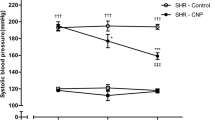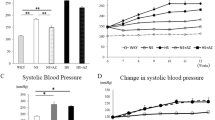Summary
Aldosterone promotes cardiovascular inflammation and remodeling, both of which are characteristic changes in hypertensive and failing hearts. Since chronic inhibition of nitric oxide (NO) synthase with N ω-nitro-L-arginine methyl ester (L-NAME) induces systemic hypertension associated with cardiovascular inflammation and remodeling, we examined the potential role of aldosterone in this process using eplerenone, a selective aldosterone receptor antagonist. Ten-week-old male Wistar-Kyoto rats were randomly divided into 3 groups: the control group (no treatment), the L-NAME group (received L-NAME 1 g/L in drinking water), and the L-NAME+Eplerenone group (L-NAME plus eplerenone at 100 mg/kg/day). After 8 weeks of the treatment, the L-NAME group showed significantly higher systolic blood pressure than the control group (198 ± 7 vs. 141 ± 3 mmHg, P < 0.05). Eplerenone did not affect the increase in blood pressure caused by L-NAME (189 ± 12 mmHg). Chronic inhibition of NO synthesis increased the plasma aldosterone concentration and CYP11B2 mRNA in adrenal glands. Cardiac inflammation and fibrosis were detected in the L-NAME group, while both changes were completely prevented by eplerenone. Cardiac hypertrophy was induced in L-NAME group, but was partially prevented by eplerenone. In the L-NAME group, left ventricular fractional shortening (LVFS: 27 ± 2 vs. 38 ± 1%) and E/A ratio (1.7 ± 0.1 vs. 2.1 ± 0.1) were significantly lower and LV end-diastolic pressure (LVEDP) was higher (4.9 ± 0.6 vs. 13.9 ± 0.5 mmHg) without LV enlargement, compared with those in the control group (P < 0.05). Eplerenone completely normalized LVFS (36 ± 2%), E/A ratio (2.2 ± 0.1), and LVEDP (6.2 ± 0.7 mmHg). These results suggest that chronic inhibition of NO synthesis induces cardiac inflammation and dysfunction via an aldosterone receptor-dependent mechanism.
Similar content being viewed by others
Reference
Yusuf S, Sleight P, Pogue J, Bosch J, Davies R, Dagenais G. Effects of an angiotensin-converting-enzyme inhibitor, ramipril, on cardiovascular events in high-risk patients. The heart outcomes prevention evaluation study investigators. N Engl J Med 2000;342:145–153.
Dahlof B, Devereux RB, Kjeldsen SE, et al. Cardiovascular morbidity and mortality in the losartan intervention for endpoint reduction in hypertension study (LIFE): a randomised trial against atenolol. Lancet 2002;359:995–1003.
Varagic J, Frohlich ED. Local cardiac renin-angiotensin system: Hypertension and cardiac failure. J Mol Cell Cardiol 2002;34:1435–1442.
McKelvie RS, Yusuf S, Pericak D, et al. Comparison of candesartan, enalapril, and their combination in congestive heart failure: Randomized evaluation of strategies for left ventricular dysfunction (RESOLVD) pilot study. The RESOLVD Pilot Study Investigators. Circulation 1999;100:1056–1064.
Brown NJ. Eplerenone: Cardiovascular protection. Circulation 2003;107:2512–2518.
Williams JS, Williams GH. 50th anniversary of aldosterone. J Clin Endocrinol Metab 2003;88:2364–2372.
Rocha R, Rudolph AE, Frierdich GE, et al. Aldosterone induces a vascular inflammatory phenotype in the rat heart. Am J Physiol Heart Circ Physiol 2002;283:H1802–H1810.
Farquharson CA, Struthers AD. Spironolactone increases nitric oxide bioactivity, improves endothelial vasodilator dysfunction, and suppresses vascular angiotensin I/angiotensin II conversion in patients with chronic heart failure. Circulation 2000;101:594–597.
Robert V, Silvestre JS, Charlemagne D, et al. Biological determinants of aldosterone-induced cardiac fibrosis in rats. Hypertension 1995;26:971–978.
McMahon EG. Recent studies with eplerenone, a novel selective aldosterone receptor antagonist. Curr Opin Pharmacol 2001;1:190–196.
Pitt B, Zannad F, Remme WJ, et al. The effect of spironolactone on morbidity and mortality in patients with severe heart failure. Randomized Aldactone Evaluation Study Investigators. N Engl J Med 1999;341:709–717.
Pitt B, Remme W, Zannad F, et al. Eplerenone, a selective aldosterone blocker, in patients with left ventricular dysfunction after myocardial infarction. N Engl J Med 2003;348:1309–1321.
Krum H, Nolly H, Workman D, et al. Efficacy of eplerenone added to renin-angiotensin blockade in hypertensive patients. Hypertension 2002;40:117–123.
Pitt B, Reichek N, Willenbrock R, et al. Effects of eplerenone, enalapril, and eplerenone/enalapril in patients with essential hypertension and left ventricular hypertrophy: The 4E-left ventricular hypertrophy study. Circulation 2003;108:1831–1838.
Kubo SH, Rector TS, Bank AJ, Williams RE, Heifetz SM. Endothelium-dependent vasodilation is attenuated in patients with heart failure. Circulation 1991;84:1589–1596.
Treasure CB, Vita JA, Cox DA, et al. Endothelium-dependent dilation of the coronary microvasculature is impaired in dilated cardiomyopathy. Circulation 1990;81:772–779.
Node K, Kitakaze M, Yoshikawa H, Kosaka H, Hori M. Reduced plasma concentrations of nitrogen oxide in individuals with essential hypertension. Hypertension 1997;30:405–408.
Landmesser U, Spiekermann S, Dikalov S, et al. Vascular oxidative stress and endothelial dysfunction in patients with chronic heart failure: role of xanthine-oxidase and extracellular superoxide dismutase. Circulation 2002;106:3073–3078.
Hornig B, Maier V, Drexler H. Physical training improves endothelial function in patients with chronic heart failure. Circulation 1996;93:210–214.
Takemoto M, Egashira K, Usui M, et al. Important role of tissue angiotensin-converting enzyme activity in the pathogenesis of coronary vascular and myocardial structural changes induced by long-term blockade of nitric oxide synthesis in rats. J Clin Invest 1997;99:278–287.
Kitamoto S, Egashira K, Kataoka C, et al. Increased activity of nuclear factor-kappaB participates in cardiovascular remodeling induced by chronic inhibition of nitric oxide synthesis in rats. Circulation 2000;102:806–812.
Sanada S, Kitakaze M, Node K, et al. Differential subcellular actions of ACE inhibitors and AT(1) receptor antagonists on cardiac remodeling induced by chronic inhibition of NO synthesis in rats. Hypertension 2001;38:404–411.
Sun Y, Zhang J, Lu L, Chen SS, Quinn MT, Weber KT. Aldosterone-induced inflammation in the rat heart: Role of oxidative stress. Am J Pathol 2002;161:1773–1781.
Qin W, Rudolph AE, Bond BR, et al. Transgenic model of aldosterone-driven cardiac hypertrophy and heart failure. Circ Res 2003;93:69–76.
Werdan K. The activated immune system in congestive heart failure—from dropsy to the cytokine paradigm. J Intern Med 1998;243:87–92.
Mann DL. Inflammatory mediators and the failing heart: Past, present, and the foreseeable future. Circ Res 2002;91:988–998.
Minamino T, Kitakaze M, Papst PJ, et al. Inhibition of nitric oxide synthesis induces coronary vascular remodeling and cardiac hypertrophy associated with the activation of p70 S6 kinase in rats. Cardiovasc Drugs Ther 2000;14:533–542.
Kuwahara F, Kai H, Tokuda K, et al. Transforming growth factor-beta function blocking prevents myocardial fibrosis and diastolic dysfunction in pressure-overloaded rats. Circulation 2002;106:130–135.
Reid EA, Kristo G, Yoshimura Y, et al. In vivo adenosine receptor preconditioning reduces myocardial infarct size via subcellular ERK signaling. Am J Physiol Heart Circ Physiol 2005;288:H2253–H2259.
Liao Y, Asakura M, Takashima S, et al. Celiprolol, a vasodilatory beta-blocker, inhibits pressure overload-induced cardiac hypertrophy and prevents the transition to heart failure via nitric oxide-dependent mechanisms in mice. Circulation 2004;110:692–699.
Ito T, Yoshimura M, Nakamura S, et al. Inhibitory effect of natriuretic peptides on aldosterone synthase gene expression in cultured neonatal rat cardiocytes. Circulation 2003;107:807–810.
Usui M, Ichiki T, Katoh M, Egashira K, Takeshita A. Regulation of angiotensin II receptor expression by nitric oxide in rat adrenal gland. Hypertension 1998;32:527–533.
Brilla CG, Weber KT. Mineralocorticoid excess, dietary sodium, and myocardial fibrosis. J Lab Clin Med 1992;120:893–901.
Sato A, Saruta T. Aldosterone-induced organ damage: Plasma aldosterone level and inappropriate salt status. Hypertens Res 2004;27:303–310.
Wang Q, Clement S, Gabbiani G, et al. Chronic hyperaldosteronism in a transgenic mouse model fails to induce cardiac remodeling and fibrosis under a normal-salt diet. Am J Physiol Renal Physiol 2004;286:F1178–F1184.
Garnier A, Bendall JK, Fuchs S, et al. Cardiac specific increase in aldosterone production induces coronary dysfunction in aldosterone synthase-transgenic mice. Circulation 2004;110:1819–1825.
Rude MK, Duhaney TA, Kuster GM, et al; Aldosterone stimulates matrix metalloproteinases and reactive oxygen species in adult rat ventricular cardiomyocytes. Hypertension 2005;46:555–561.
Ahokas RA, Sun Y, Bhattacharya SK, Gerling IC, Weber KT. Aldosteronism and a proinflammatory vascular phenotype: role of Mg2+, Ca2+, and H2O2 in peripheral blood mononuclear cells. Circulation 2005;111:51–57.
Luft FC. Workshop: Mechanisms and cardiovascular damage in hypertension. Hypertension 2001;37:594–598.
Niu XF, Smith CW, Kubes P. Intracellular oxidative stress induced by nitric oxide synthesis inhibition increases endothelial cell adhesion to neutrophils. Circ Res 1994;74:1133–1140.
De Caterina R, Libby P, Peng HB, et al. Nitric oxide decreases cytokine-induced endothelial activation. Nitric oxide selectively reduces endothelial expression of adhesion molecules and proinflammatory cytokines. J Clin Invest 1995;96:60–68.
Chhokar VS, Sun Y, Bhattacharya SK, Ahokas RA, Myers LK, Xing Z, Smith RA, Gerling IC, Weber KT. Hyperparathyroidism and the calcium paradox of aldosteronism. Circulation 2005;111:871–878.
Murray DR, Freeman GL. Proinflammatory cytokines: Predictors of a failing heart? Circulation 2003;107:1460–1462.
Harada E, Yoshimura M, Yasue H et al. Nakamura S, Kuwahara K, Saito Y, Nakao K, Ogawa H. Aldosterone induces angiotensin-converting-enzyme gene expression in cultured neonatal rat cardiocytes. Circulation 2001;104:137–139.
Burlew BS, Weber KT. Cardiac fibrosis as a cause of diastolic dysfunction. Herz 2002;27:92–98.
Douglas PS, Tallant B. Hypertrophy, fibrosis and diastolic dysfunction in early canine experimental hypertension. J Am Coll Cardiol 1991;17:530–536.
Tsao PS, Wang B, Buitrago R, Shyy JY, Cooke JP. Nitric oxide regulates monocyte chemotactic protein-1. Circulation 1997;96:934–940.
Ni W, Egashira K, Kataoka C, et al. Antiinflammatory and antiarteriosclerotic actions of HMG-CoA reductase inhibitors in a rat model of chronic inhibition of nitric oxide synthesis. Circ Res 2001;89:415–421.
Author information
Authors and Affiliations
Corresponding author
Rights and permissions
About this article
Cite this article
Tsukamoto, O., Minamino, T., Sanada, S. et al. The Antagonism of Aldosterone Receptor Prevents the Development of Hypertensive Heart Failure Induced by Chronic Inhibition of Nitric Oxide Synthesis in Rats. Cardiovasc Drugs Ther 20, 93–102 (2006). https://doi.org/10.1007/s10557-006-8130-0
Published:
Issue Date:
DOI: https://doi.org/10.1007/s10557-006-8130-0




